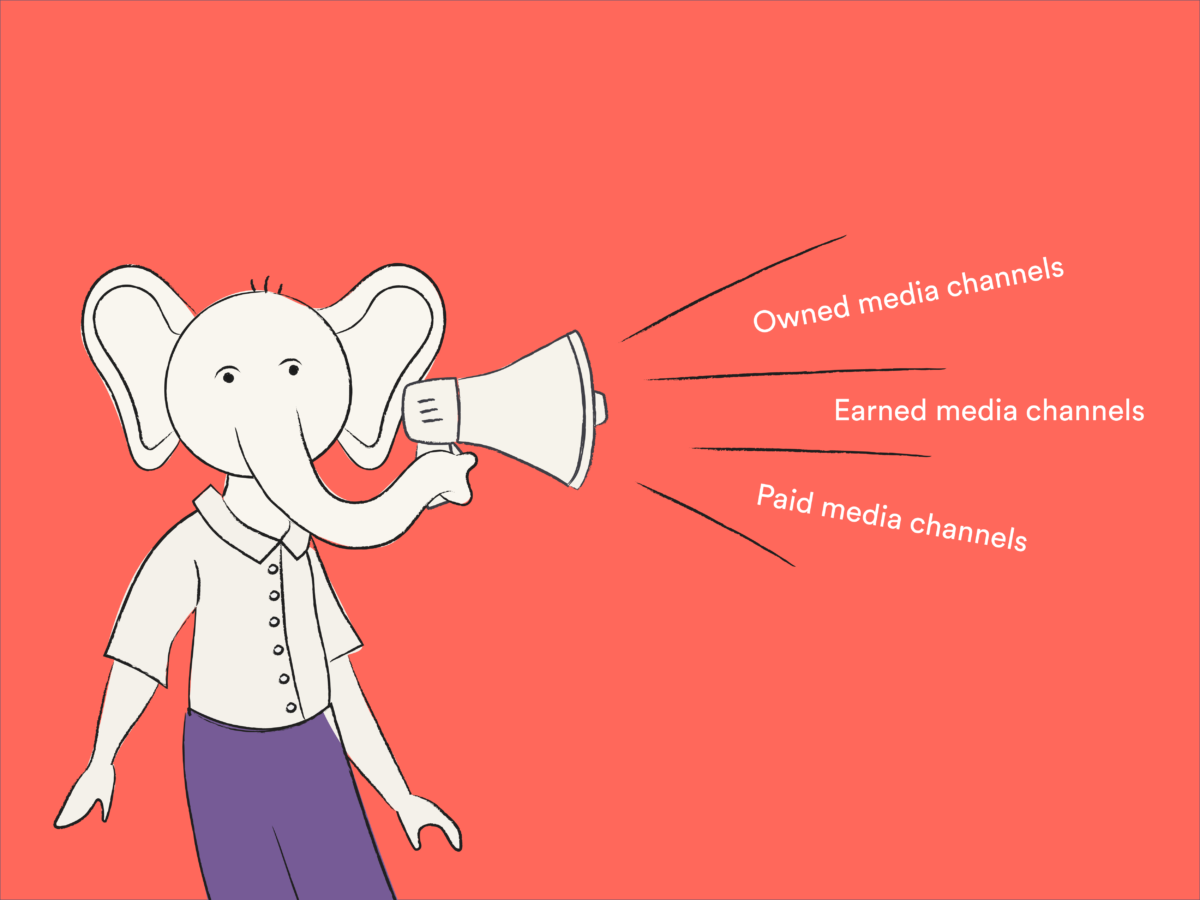Are you noticing that your content isn’t making as much of a buzz as you were hoping? There could be multiple causes of this which all come down to your content distribution strategy being a bit lousy.
Don’t feel dejected, though, because many brands have to go through extensive planning when it comes to sharing content at optimal times. In fact, companies with successful marketing are spending at least 40% of their budget on content strategy.
To get your content out there and seen by those who matter, here is what you should know about the warning signs of a bad strategy, and how you can bring it back to life.
Knowing when to refine your content distribution strategy
There are many ways that your company, which you’ve crafted from the ground up with love and hard work, can be harmed if you don’t have an effective way of getting your ideas out there.
Here are just some of the negative impacts poor content distribution can have:
- Limits brand awareness: When you don’t use the right piece of content, platforms, and timing, you may as well be shouting into the void.
- Loses to competition: If you want to give yourself a strong chance of squashing competition, having a strong strategy is crucial.
- Wastes resources: Money, time, and skills are all wasted if you don’t put them in the right place. To achieve a return on investment (ROI), you need to make your investments worth it in the long run through effective content distribution.
- Misses engagement opportunities: Having amazing opportunities pass you by hurts when it could’ve taken your company to the next level.
- Hinders growth: All of this leads to your company losing the ability to grow. Without a target audience and consistent income, it won’t be long until your head is under water.
Now you know refining your content distribution strategy is important, but what are the warning signs that indicate a need for action?
Falling website traffic
As with the natural ups and downs of life, it is normal for website traffic to fluctuate due to time and trends, which are only getting more complicated.
But, if it continuously declines and isn’t bouncing back as it used to, it’s a big sign that your content strategy is no longer cutting it. The right people aren’t seeing it, or if they are not engaging with it.
Consistently high website traffic is crucial for keeping your brand on the map and ranking on search engines. It’s a beautiful cycle where the more traffic you bring in, the more you get. To keep an eye on your visitors, use analytics tools such as Google Analytics and HubSpot for accessible insight into bounce rates and conversion rates.

Low engagement
You may be scraping together some loyal visitors to your website and social media channels, but if they aren’t picking up what you’re putting down by commenting, liking, and converting, then you may as well be talking to no one.
To make users engage with your content, it must be engaging and relevant to what they are looking for. Getting people talking about your brand is key to finding new audiences and generating backlinks.
Inconsistent results
With any new business or organization, a lot of investment is required to get it up and running. It’s a huge financial risk because it’s impossible to know whether a company will be profitable or not.
This is why it is so important to have consistent results. Knowing when your income comes and goes gives you the flexibility and peace of mind to make investments in the company without running out of money.
Steps to refining your content distribution strategy
Establishing an effective content distribution strategy takes multiple steps in order to get everything in place and provide the best results.
1. Know your target audience
Understanding your target audience is crucial for refining your content distribution strategy. Having a clear idea of who your ideal customers are and what they like helps you tailor marketing efforts to what they want to see.
There are lots of ways that you can gather information about what your target audience should be:
- Know your objective: What are you hoping to achieve as a company and why? Answering these questions will give you realistic goals and a solid brand.
- Customer research: Carry out research on your current customers by providing surveys asking what they like about your company, what they would change, etc.
- Market research: The best way to find your audience is to put your message out there and see who resonates.
- Analyze competitors: In order to stay in the race, you have to keep an eye on your competitors. See what they are doing and try it yourself.
2. Create high-quality content
When you create high-quality content, you’re providing something valuable, informative, or entertaining to your audience. This grabs attention and keeps people engaged. Consistently delivering high-quality input helps establish your brand as a trusted source of information.
97% of companies use content marketing, and so should you. It is the practice of sharing content without directly trying to sell anything to users.
If you see a cool blog post that aligns with your company’s message, you can bet that your customers will want to see it, too, whether it be Infographics, podcasts, or case studies. It’s a great way to connect to your customers on another level and demonstrate that you are not only here to sell your products.
3. Identify relevant distribution channels
Just like people have their favorite hangout spots, your target audience has preferred channels where they spend their time.
By identifying these different channels, whether social media apps, industry forums, or specific websites, you can strategically position your content where it’s most likely to be seen by the right people. It’s like setting up shop in the heart of a bustling marketplace.
Each distribution channel has its own unique characteristics and preferences. It’s like speaking different languages to communicate with diverse audiences effectively.
Tailoring your content to fit the format, style, and tone of each channel lets you capture attention and engage your audience more effectively. It’s about serving the right dish in the right ambience.
4. Search engine optimization (SEO)
SEO techniques ensure that your content is among the first to appear in search engine results when users search for relevant topics or keywords. There are various aspects that you will have to optimize, but once done, it will bring in consistent, organic traffic.
Here are some ways you can achieve SEO for your digital channels:
- Keyword research: The first ingredient that goes into making a delicious SEO soup is keywords. These are the words and phrases that are commonly used when searching for similar content. By incorporating these keywords throughout, you’ll have a much higher chance of bringing in website traffic.
- On-page optimization: This is the type of SEO that is done on the page and includes images, headers, and meta tags. Incorporate keywords throughout these elements but don’t be too heavy-handed; it won’t read well if you cram them in. A top tip is to incorporate a call-to-action on the landing page to keep web traffic moving through the sales funnel.
- High-quality content: It’s not just about what you say; it’s how you say it. If your content is original, helpful, and engaging, people will share it and open the door to a wider audience. With frequent website visitors, search engines will deem it reputable.
- Regular updates: Don’t leave your website to become irrelevant and clunky; it requires frequent TLC through frequent content updates and website maintenance. This not only provides a smooth user experience but also keeps it relevant in the eye of search engines.

SEO provides valuable data and insights that can establish a content distribution strategy. By analyzing metrics like search rankings, click-through rates, and user behavior on your website, you can gain insights into the performance of your marketing.
This data helps you understand what resonates with your audience, identify opportunities for improvement, and make data-driven decisions to optimize your strategy.
If you have money to spare, you can go down the route of Pay-Per-Click (PPC), which is a type of advertising where advertisers pay you for every click you get. These campaigns are usually run through social media ads and bring traffic to your site.
5. Embrace social media
Social media is not just for cute cat pictures; in fact, 55% of people learn about brands through social media. This makes it the perfect place to get your name out there and give your company a chance to skyrocket to planet profit.
Social media marketing is broad and encompasses community engagement, paid advertising, and audience insights. It can take a bit of time to get right but don’t panic because once you crack the code, those precious numbers will rise.
Channels like Facebook, Instagram, Twitter, LinkedIn, and others can expand the reach of your content to a wider demographic. Instagram alone has over 2 billion monthly users, so you can only imagine the audience you could get from there.

This exposure can help attract new followers and start valuable feedback. Be open to hearing what your audience has to say about you because, in this instance, it could make all the difference.
6. Have an effective email marketing strategy
Email marketing enables you to communicate directly with your audience. You can send your content straight to their inboxes in the form of email newsletters and webinars, ensuring that your message reaches them without relying on other platforms.
You can create customer personas by segmenting subscribers based on their interests, preferences, or demographics. This allows you to send them content relevant to their specific needs and increase the chances of engagement and conversion.
Once you have the basics figured out, you can use automation with digital marketing tools to take care of the rest. You can set up prompts for emails to send when a customer is in a particular part of the sales funnel or when their birthday rolls around with special offers.
7. Collaborate with influencers
Influencers have a large following on social media platforms, and by partnering with them, you can reach their audience and expose your voice to a new group of people who might be interested in what you have to offer.
Influencers often have a strong connection with their followers because they share similar interests, lifestyles, or values. When an influencer collaborates with you, their audience sees it as a genuine partnership, making your brand more appealing and relatable.
Using influencer marketing in different niches lets you adapt your content to different formats and reach a wider range of people you may have never considered before.
8. Measure and analyze performance
Performance measurement helps you optimize your types of content distribution. You can identify the most effective channels and platforms for reaching your target audience.
Thanks to modern technology and marketing platforms, you can measure in detail exactly how well your content is performing.
Key performance indicators (KPIs) such as click-through rates, time spent on the page, and social media shares provide valuable metrics for identifying what parts of your strategy work and what parts need improvement.
9. Continuous testing and improvement
Testing allows you to try out different strategies and techniques. By experimenting with various content distribution plans, you can gather valuable insights about what works best for your audience.
Continuous improvement means making small, incremental adjustments over time and is the best way to achieve better results down the road.

Refine your path to success
Without a finely tuned content distribution strategy, you can wave goodbye to your hard work as it shoots off into the abyss, never to be seen again.
But, by taking the time to carefully strategize what types of content you want to create and how you want to share them, then you can captivate your target audience and drown out the competition in the process.










